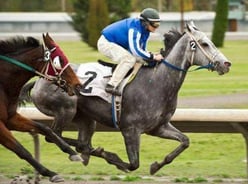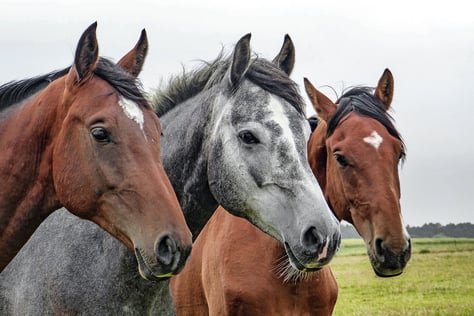
If you are ready for a new horse – whether it’s your first or your 10th – you might want to consider the Off-Track Thoroughbred (OTTB). In the recent Thoroughbred Makeover series, Thoroughbreds have proven that they are all-discipline horses, from dressage to driving to jumping to working cattle. This article will tell you what I’ve learned from my experience buying Lotta Promise (a/k/a Stormy), a 2007 Oregon-bred grey gelding. If you know the horse’s racing name (or lip tattoo number), you can find out a lot of information about a potential OTTB purchase on Equibase, Thoroughbred racing's best database. This includes a free five-generation pedigree and their complete racing history. The good news about Stormy was that he is a grandson of Triple Crown winner Seattle Slew. The bad news was that in 15 starts, he wasn’t very successful – one win and no place or show earnings.
Breeding and training a Thoroughbred for the race track is a huge gamble. As Stormy’s record indicates, just because he had great breeding doesn’t mean he was a great race horse. Horse racing is very expensive and most owners/breeders/trainers are in it for the love of the sport, not the money. Still, that means each year they have to evaluate their stock and decide who to keep and who to let go. Your best bet to get one of these OTTB at a great price is to talk to one of the owners/breeders/trainers at the track. They can be found on what’s called the “backside” where all the stables are. The best time is at the end of the race “meet” (the months the track offers Thoroughbred racing).
Why is an OTTB a good deal?
They are typically still young. Thoroughbreds start racing as two-year-olds and don’t race much past five unless they are super-awesome. They are thoroughly familiar with the noise and commotion that goes on at a race stable. Blaring announcements, people, music – all are a daily part of a race horse’s life and they soon become bored by it. That’s not to say they can’t get spooky once they are getting ready to race. But they are used to standing for the shoer, vet exams and baths. Because they travel a lot, as well as have a lot of experience being squeezed into those starting gates, most OTTB’s are OK with trailer loading. And, let’s face it – these horses are typically inexpensive, even free.
What to think about before buying an OTTB
Be absolutely truthful about what your level of riding experience is. While OTTB’s are used to being ridden, they are ridden totally different than our conventional riding aides. First of all, OTTB’s expect to run each time they are saddled up. And don’t even think you’ll control their speed by pulling back on the reins. To race horses, pressure on the mouth means GO FASTER!
Most OTTB’s don’t know about weight aides, leg pressure, being on the bit or bending. OTTB’s will need to be taught how to jump or do lead changes or become cow savvy. So before buying an OTTB, I would strongly suggest you partner up with a trainer who has OTTB training experience. Retraining an OTTB is different than training a young horse – in fact, there’s probably more untraining being done than training. So find a trainer who knows how to communicate with these horses.
Finally, no matter what the cost of the OTTB, remember there’s no such thing as a “free horse.” Absolutely get a vet pre-purchase exam, including x-rays. Over a Thoroughbred’s race career, he could have been on legal therapeutic drugs such as Lasix or (hopefully not) an illegal drug that could impact his future health.
OTTB’s legs are always questionable, which is why x-rays are important. Talk to your vet about what you can live with based on the type of riding you will do. If you’re just doing trail riding, a chipped knee may not be a problem. If you’re hoping to go eventing, it could be. OTTB’s feet are another issue to consider. Thoroughbreds typically have low slung heels which can lead to navicular problems. And because of frequent shoeing, an OTTB can have “shelly feet” and difficulty keeping shoes on.
What about Stormy?

I bought Stormy from a trainer at a race track whom I knew and trusted. He was seven at the time (11 ow). Initially, I took him to a barn with an excellent trainer who understood OTTBs and gave him high-quality feed and lots of turnout time and slow, gentle reeducation for both Stormy and me! After I brought him home, I removed his shoes and he has been barefoot and that has really improved the shape and quality of his hooves. We are just enjoying riding in our pasture or around our property and he’s accepted my “boss mare,” the two dogs and assorted barn cats. For me, Stormy was the deal of a lifetime.
photo credit: Portland Meadows Racetrack, Stormy's mom



